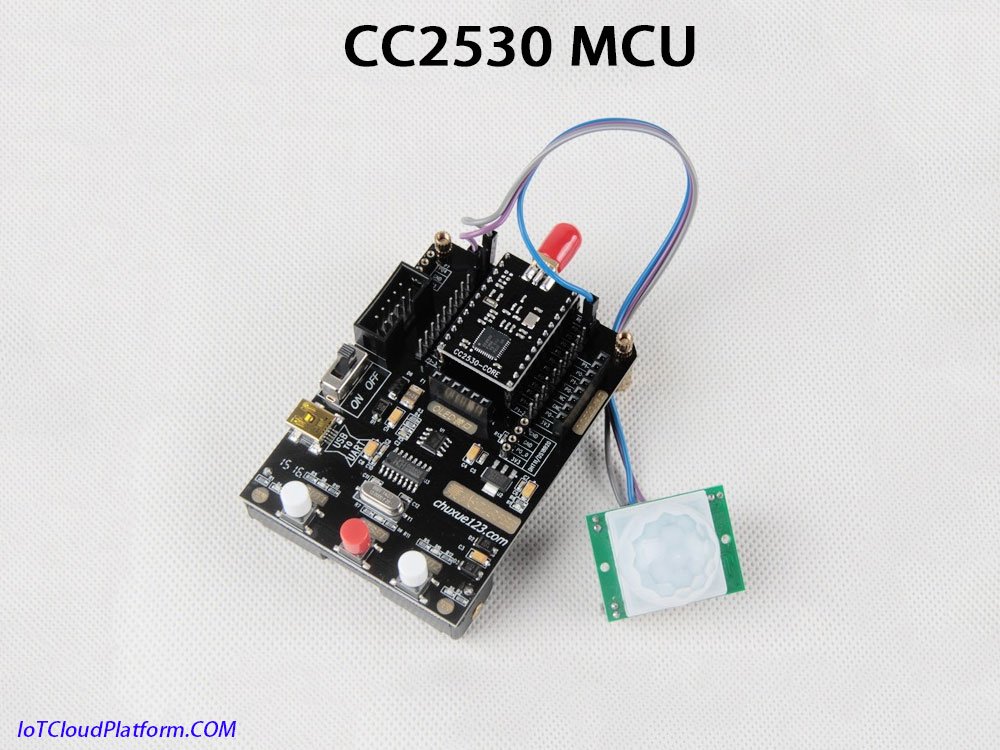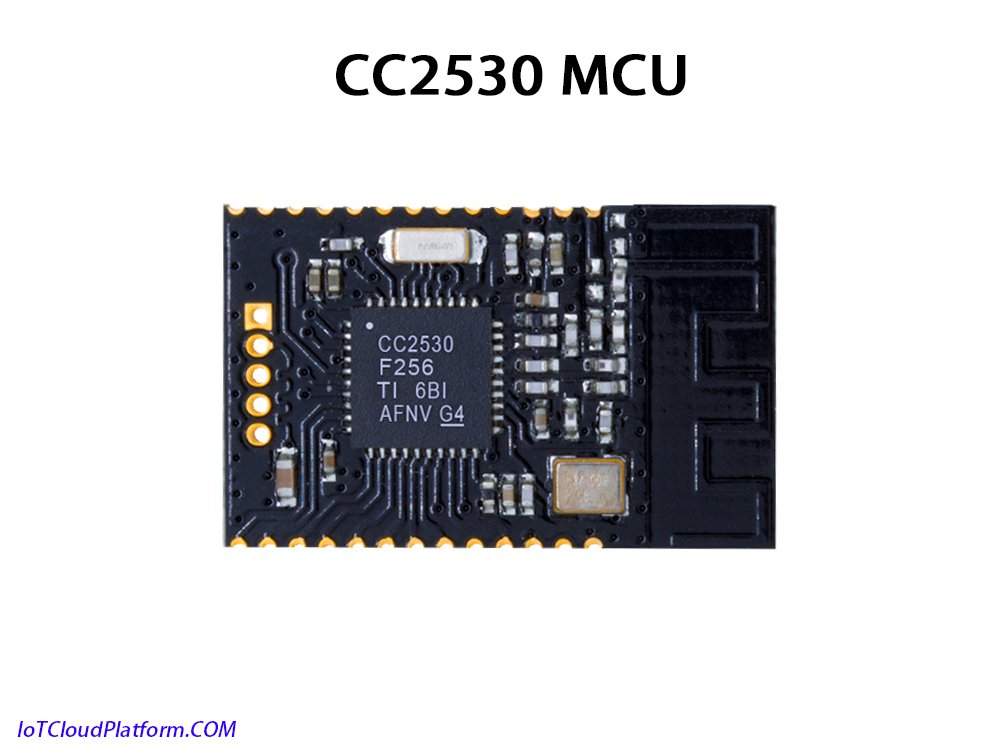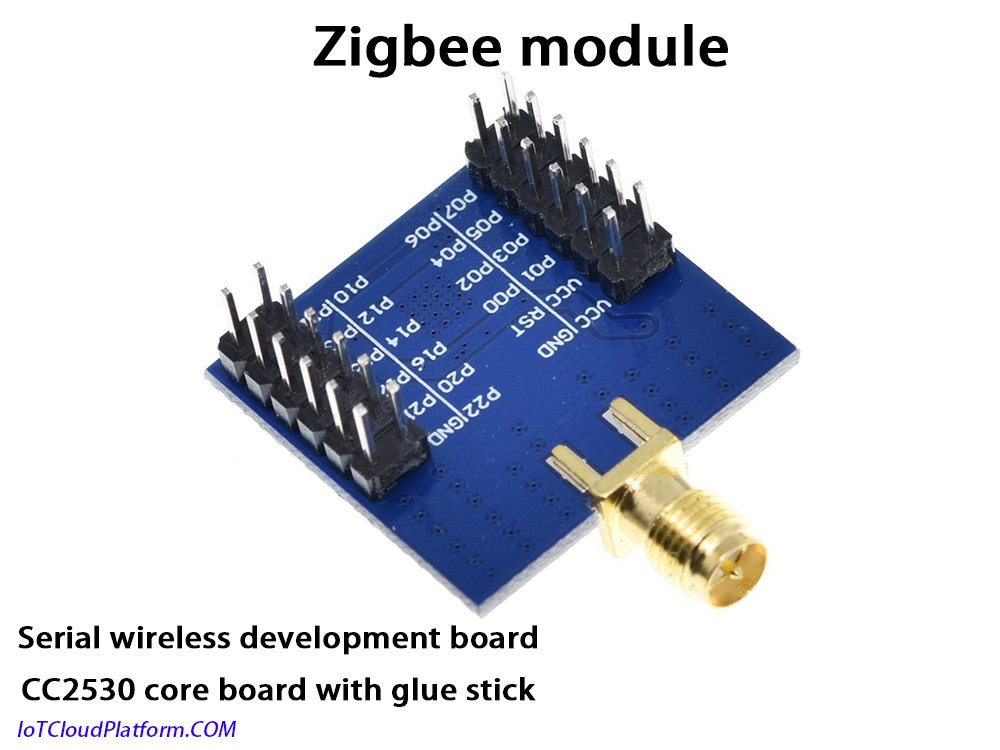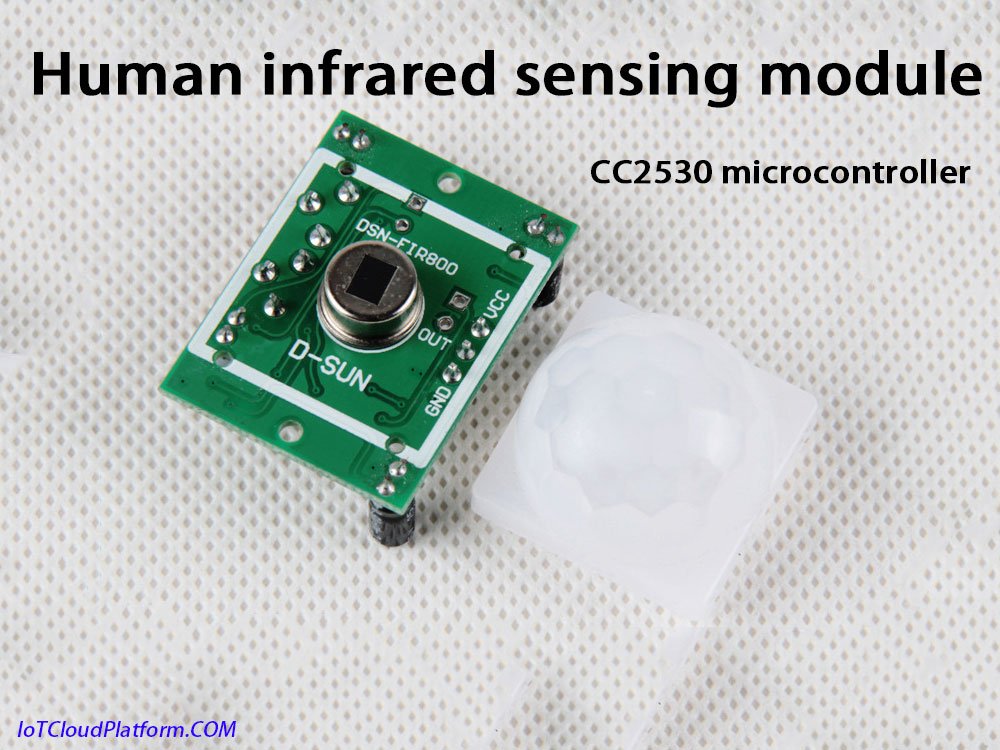
CC2530 MCU Technology Detailed Explanation
The CC2530 MCU is a high-performance, low-power system-on-chip (SoC) solution designed for 2.4GHz IEEE 802.15.4, ZigBee and RF4CE applications.
The following is a detailed technical introduction to the CC2530 MCU, covering all its key aspects.
Overview
The CC2530, launched by Texas Instruments, combines an advanced RF transceiver, an industry-standard enhanced 8051 CPU, in-system programmable flash memory, 8KB RAM and many other powerful features. It provides four different flash versions: CC2530F32/64/128/256, with 32/64/128/256KB of flash memory, respectively, to adapt to applications with different requirements. CC2530 is particularly suitable for systems with ultra-low power requirements, such as the Internet of Things, smart homes, industrial automation and smart security.
Zigbee wireless RF CC2530 module A2 self-organizing network serial port transparent transmission smart home coordinator microcontroller
Core Features
1. RF Transceiver:
- RF transceiver that complies with the 2.4GHz IEEE 802.15.4 standard.
- Extremely high receiving sensitivity and anti-interference performance.
- Programmable output power up to 4.5 dBm.
- Only a few external components are required, and only one crystal oscillator is required to meet the needs of mesh network systems.
- 6mm × 6mm QFN40 package, suitable for system configurations that comply with radio frequency regulations worldwide.
2. Microcontroller:
- Adopts an enhanced 8051 core with excellent performance and code prefetching capabilities.
- Provides 32/64/128KB of in-system programmable flash memory and 8KB RAM.
- Supports hardware debugging for easy development and testing.
3. Low Power:
- Consumes only 24 mA in active mode RX (CPU idle).
- Active mode TX consumes 29 mA at 1dBm (CPU idle).
- Multiple power modes, such as 0.2 mA in power mode 1 (4 μs wake-up), 1 μA in power mode 2 (sleep timer running), and 0.4 μA in power mode 3 (external interrupt).
4. Memory and interface:
- The memory arbiter connects the CPU, DMA controller, physical memory, and all peripherals through the SFR bus.
- Provides a rich set of interfaces and peripherals, including UART, SPI, I2C, GPIO, etc., to facilitate communication and interaction with other devices.
- Supports analog and digital interfaces, and can connect various external devices such as sensors and actuators.
Pins and functions
CC2530 has 40 pins, including 21 digital I/O ports (P0, P1, and P2). These ports can be configured as general I/O ports or external device I/O ports, and each I/O port can be configured as an input pin for an external interrupt source. In addition, CC2530 also provides multiple special function registers (SFRs) for controlling the internal devices and status information of the microcontroller.
Operation Mode and Reset
CC2530 has different operation modes to adapt to ultra-low power requirements. The short transition time between these modes further ensures low energy consumption. At the same time, CC2530 has five different reset sources to ensure that the system can be properly reset under different conditions.
Peripherals and Functional Expansion
CC2530 integrates many powerful peripherals to meet various application needs:
- 5-channel DMA: Provides efficient data transmission capabilities.
- IEEE 802.15.4 MAC Timer: Supports time management of wireless communication protocols such as ZigBee.
- General Timer: Includes a 16-bit timer and two 8-bit timers for various timing tasks.
- IR Generation Circuit: Supports infrared communication function.
- 32kHz Sleep Timer with Capture Function: Used for time management in low power mode.
- Hardware Support CSMA/CA: Provides carrier sense multiple access/collision avoidance mechanism to support stable communication of wireless networks.
- Supports accurate digital RSSI/LQI: used to evaluate the strength and link quality of wireless signals.
- Battery monitor and temperature sensor: Provides battery power monitoring and temperature detection functions.
- 12-bit ADC: With 8 inputs and configurable resolution, it is used for digital processing of analog signals.
- AES security coprocessor: Provides data encryption and decryption functions to enhance system security.
- 2 USART: Supports multiple serial communication protocols to facilitate data exchange with other devices.
Development environment and tools
Zigbee module Ticc2530 development board module serial wireless development board CC2530 core board with glue stick
In order to effectively use the CC2530 microcontroller, you need to understand and follow a certain development process. This usually involves hardware preparation, software installation, code writing, program burning, and debugging and testing. Specifically:
1. Hardware requirements:
Prepare a CC2530 development board and a programmer that supports CC2530.
In order to carry out development work based on CC2530, you first need to prepare a CC2530 development board. This development board integrates the CC2530 chip and its necessary peripheral circuits, providing developers with a complete hardware platform. In addition, a programmer compatible with CC2530 is required to burn the written program code into the CC2530 chip on the development board for subsequent debugging and testing. These hardware are the basis for CC2530 development.
2. Software requirements:
Download and install the CC2530 burning program and integrated development environment (such as IAR Embedded Workbench for 8051). At the same time, you need to download and compile the CC2530 application.
3. Install the driver:
Install the driver of the emulator (such as SmartRF4EB) to ensure normal communication between the development board and the computer.
4. Install the burning tool:
Such as Setup_SmartRF_Programmer, used to burn the compiled code to the CC2530 development board.
5. Install the protocol stack:
For example, the Zigbee protocol stack ZStack-CC2530-2.5.1a provided by TI is an indispensable part of developing wireless applications.
During the development process, developers can use the powerful editors, compilers and debugging tools provided by integrated development environments such as IAR to write, compile and debug codes. At the same time, the program can be burned to the development board through the emulator and burning tool for physical testing and verification.
Human infrared sensing module CC2530 microcontroller
Application scenarios and examples
CC2530 is widely used in various fields due to its low power consumption, high performance and powerful processing capabilities. Here are some typical application scenarios and examples:
1. Internet of Things:
CC2530 can be used to build wireless sensor network nodes in IoT devices to realize data collection, transmission and processing. For example, CC2530 is used to collect environmental parameters (such as temperature, humidity, etc.) and transmit them to the central controller through the ZigBee network for analysis and processing.
2. Smart Home:
CC2530 can be used to control various devices in smart home systems. For example, the switch, brightness and color temperature of smart bulbs can be controlled through the ZigBee network; or CC2530 can be used as the controller of the access control system to realize the wireless access control function.
3. Industrial Automation:
In the field of industrial automation, CC2530 can be used to build wireless sensor networks and remote control systems. For example, use CC2530 to monitor the operating status and parameters of the production line, and transmit the data to the monitoring center through the wireless network for analysis and processing; or use CC2530 to realize the control and adjustment functions of remote devices.
4. Intelligent Security:
In the field of intelligent security, CC2530 can be used to build wireless alarm systems and monitoring networks. For example, use CC2530 as the controller of the door and window sensor, and when the door and window are illegally opened, the alarm signal is triggered and transmitted to the monitoring center through the wireless network; or use CC2530 to realize the video transmission and monitoring functions of the wireless camera.
The following is a simple sample code that shows how to use CC2530 for ZigBee communication:
#include <stdint.h>
#include "ti_driverlib.h"
#include "simplelink.h"
#include "zstackapi.h"
void ZstackCallback(zstack_dev_ui_event_t * evt);
void main() {
uint32_t Initialized;
zstack_sysConfig_t sysCfg;
zstack_deviceTypes_t devTypes;
// Initialize the protocol stack
Zstackapi_init();
// Set system configuration
sysCfg.channelList = CHANNEL_MASK;
sysCfg.logicalType = zstack_LogicalTypes_COORDINATOR;
sysCfg.pNwkInfo = NULL;
sysCfg.rfModule = zstack_rfModule_CC2530EM;
sysCfg.scanDuration = 4;
Zstackapi_sysConfig(&sysCfg);
// Configuring device type
devTypes.appDev = zstack_AppDev_NONE;
devTypes.devPart = zstack_DevPart_ROUTER;
// Start the protocol stack
Simplelink_start();
// Wait for initialization to complete
while (!Initialized) {}
// Registering event handling functions
Zstackapi_setCallbacks(ZstackCallback, NULL);
while(1);
}
void ZstackCallback(zstack_dev_ui_event_t * evt) {
if (evt->eventId == zstack_eventIds_DEVICE_READY) {
// The device enters the ready state
Zstackapi_bdbStartCommissioning(zstack_BdbCommissioningMode_NetworkFormation,
zstack_BdbGpdCommissioningMode_None);
}
}The sample code shows how to initialize the ZigBee protocol stack, set the system configuration and device type, start the protocol stack, and register the event handling function.
When the device is ready, the Zstackapi_bdbStartCommissioning() function will be called for network formation to establish a ZigBee network.
It should be noted that this sample code is only a simple demonstration and does not fully implement the ZigBee communication protocol. In actual applications, routing, security and other issues need to be considered.
Summary
1. High performance and low power consumption:
- CC2530 combines powerful features such as advanced RF transceiver, enhanced 8051 CPU and in-system programmable flash memory to provide a high-performance wireless communication solution.
- At the same time, CC2530 has multiple low-power modes, which enables the device to significantly reduce power consumption when not in use and extend battery life.
2. Flexible flash memory version:
- CC2530 provides multiple flash memory versions (CC2530F32/64/128/256), with 32/64/128/256KB of flash memory space respectively, to meet the needs of different applications.
3. Rich peripherals and interfaces:
- CC2530 integrates a variety of peripherals, such as DMA, MAC timer, general timer, IR generation circuit, etc., and provides a wealth of interface options, such as UART, SPI, I2C, etc., which facilitates communication and interaction with other devices.
4. Easy to develop and debug:
- CC2530 supports hardware debugging. Developers can use the development tools and software support provided by TI to quickly build a stable and reliable wireless communication system.
- At the same time, the development environment of CC2530 is mature, with a large amount of development materials and community support, which reduces the difficulty of development.
5. Wide application fields:
- CC2530 is widely used in home automation, industrial control, sensor networks and the Internet of Things due to its low power consumption, high performance and powerful processing capabilities.
Prospects
1. Technology upgrade and innovation:
- With the continuous development of wireless communication technology, CC2530 microcontrollers will also continue to upgrade and innovate technology to adapt to new application scenarios and needs.
- For example, higher-performance CPU cores, more advanced RF transceivers, and more peripheral options may be introduced in the future.
2. Expansion of IoT applications:
- With the rapid development of IoT technology, the CC2530 MCU has broad application prospects in the field of IoT.
- It can be used as a core node in the IoT to realize functions such as data collection, transmission and processing, and provide strong support for smart homes, smart cities and other fields.
3. Improvement of the ecosystem:
- With the widespread application of CC2530 MCU, its ecosystem will continue to improve.
- This includes the improvement of development tools, software libraries, development boards and community support, which will provide developers with a more convenient and efficient development environment.
4. Improvement of security and reliability:
- In future development, CC2530 MCU will pay more attention to the improvement of security and reliability.
- By integrating more security coprocessors, encryption algorithms and hardware-level security protection mechanisms, the security of data transmission and the reliability of the system are ensured.
In summary, as a high-performance, low-power system-on-chip solution, the CC2530 microcontroller has broad application prospects in the field of wireless communications. In the future, with the continuous development of technology and the continuous expansion of application scenarios, the CC2530 microcontroller will usher in a broader development space and opportunities.

About IoT Cloud Platform
IoT Cloud Platform focuses on IoT technology, cutting-edge technology, IoT product sales and wholesale, and advertising alliance cooperation. If you need to purchase IoT products, including IoT WiFi modules, Bluetooth modules, low-power modules, electronic components, PCB design, IoT Cloud Platform advertising alliance, please contact us.
FAQs
Here are some common questions about the CC2530 microcontroller and their brief answers:
CC2530 is a high-performance, low-power system-on-chip (SoC) solution specifically designed for 2.4GHz IEEE 802.15.4, ZigBee and RF4CE applications.
CC2530 supports the IEEE 802.15.4 standard, as well as ZigBee, ZigBee PRO and ZigBee RF4CE standards.
CC2530 has extremely high receiving sensitivity and anti-interference performance, programmable output power up to 4.5 dBm, provides multiple flash versions (32/64/128/256KB), has powerful network node establishment capabilities, and is especially suitable for systems with ultra-low power requirements.
The CC2530 is outstanding in low power consumption, consuming only 24 mA in active mode RX (CPU idle) and 29 mA in active mode TX at 1 dBm (CPU idle). The power mode consumes even less, such as 0.2 mA in power mode 1 (4 μs wake-up).
The CC2530 provides multiple power management modes, including active mode, power mode, etc., to achieve low power operation. The device can return to idle mode from active mode or wake up from sleep mode.
The CC2530 uses an enhanced 8051 core with excellent performance and code prefetching.
What is the memory configuration of the CC2530? The CC2530 provides 32-, 64-, or 128-KB of in-system programmable flash and 8-KB RAM, and supports hardware debugging.
CC2530 integrates many peripherals such as powerful 5-channel DMA, IEEE 802.15.4 MAC timer, general timer, IR generation circuit, 32-kHz sleep timer with capture function, hardware support for CSMA/CA, support for accurate digital RSSI/LQI, battery monitor and temperature sensor.
CC2530 provides a wealth of interfaces and peripherals, including UART, SPI, I2C, GPIO, etc., to facilitate communication and interaction with other devices.
Development with CC2530 usually involves a series of steps such as preparation, environment construction, code writing, program burning and debugging testing. Developers can use the development tools and software support provided by TI to quickly build a stable and reliable Zigbee communication system and realize customized applications.
CC2530 is widely used in home automation, industrial control, sensor networks and the Internet of Things due to its low power consumption, high performance and powerful processing power.
If CC2530 cannot correctly receive information on a specific channel during reception, you may need to check the register settings related to frequency calibration to ensure that the receiving frequency is correct. In addition, you also need to check whether the interrupt processing and signal processing capabilities are normal.






